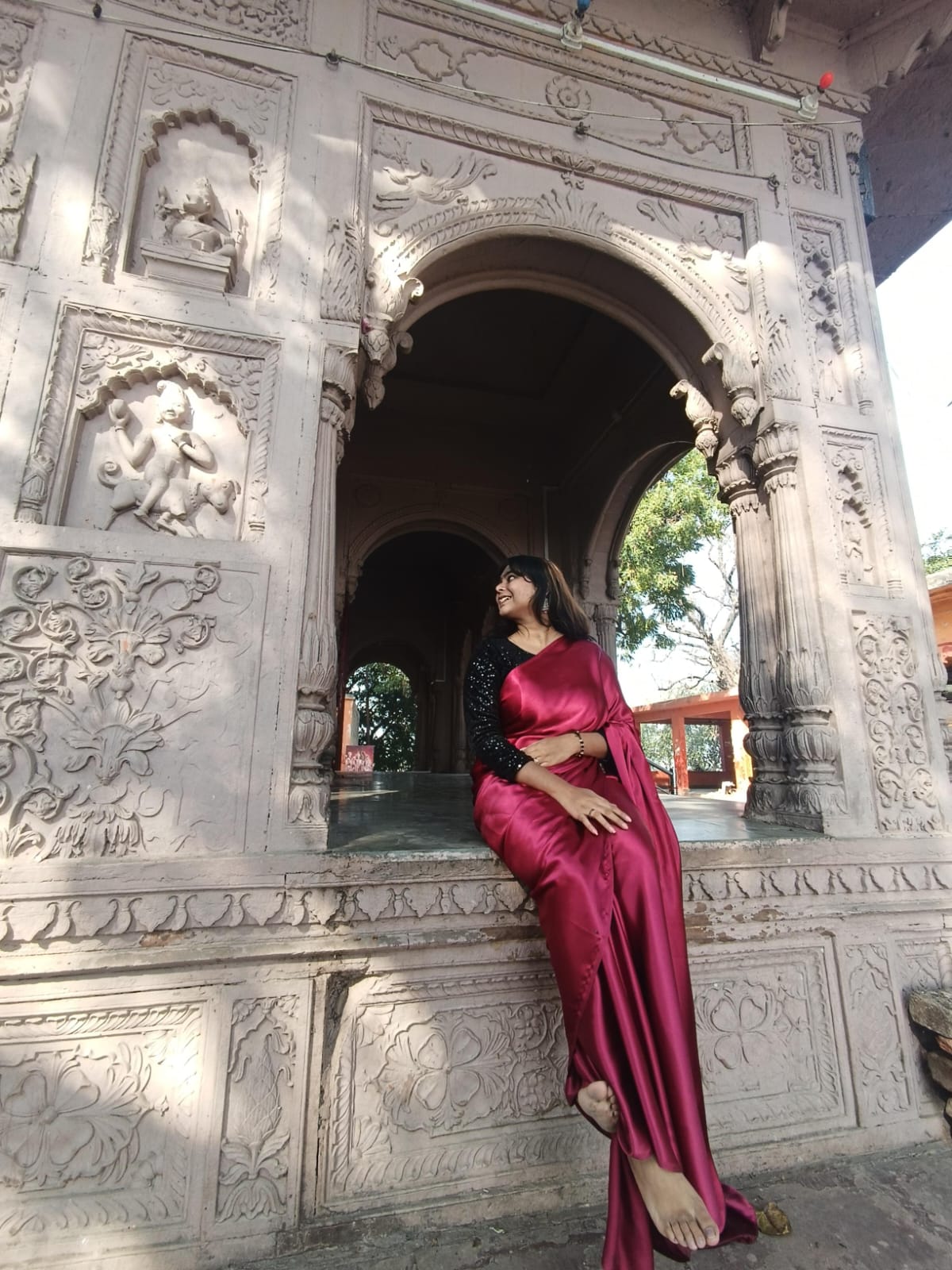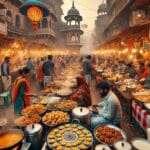Explore the timeless legacy of Varanasi Handloom Saree, showcasing Banarasi elegance, rich silk craftsmanship, and centuries-old weaving traditions.

Why Banarasi Sarees are a National Treasure
When you hear “Banarasi saree,” your mind likely conjures images of regal silk, ornate gold zari work, and a piece of fabric that exudes timeless elegance. Banarasi sarees are more than just garments—they are cultural symbols, handcrafted artworks, and heirlooms passed down through generations. Their significance is so profound that no Indian wedding feels complete without the bride adorning one.
Originating from the ancient city of Varanasi, these sarees represent centuries of weaving mastery. Each saree takes weeks, sometimes months, to complete—an intricate process that weaves not only threads but stories, traditions, and artistic passion into every inch. What makes Banarasi sarees even more special is their universal appeal. While rooted in deep cultural traditions, they transcend age and geography, effortlessly blending with both traditional and modern wardrobes.
And let’s not forget their place in Indian festivals. Whether it’s Diwali, Durga Puja, or Eid, a Banarasi saree adds grandeur to any celebration. This is not just fashion; it’s heritage draped in six yards of woven elegance.
The Cultural Essence of Varanasi Weaves
Varanasi, also known as Kashi or Banaras, is one of the oldest living cities in the world. Every ghat, temple, and by-lane in this city tells a story. And among those stories, the handloom sarees hold a special place. In the rhythmic clatter of wooden looms, generations of weavers have continued a legacy that is as spiritual as the city itself.
For the people of Varanasi, weaving isn’t just a livelihood—it’s an offering, a tribute to art and divinity. Many believe that the designs and motifs used in Banarasi sarees are inspired by the gods and nature. From blooming lotuses and flowing vines to peacocks and traditional butis, each motif is a visual poem paying homage to the sacred essence of the city.
The saree, thus, is not just a product; it is a piece of Varanasi itself. It embodies the city’s soul—resilient, radiant, and revered.
A Historical Tapestry – The Origins of Banarasi Sarees
Influence of the Mughal Era
The history of Banarasi sarees is deeply intertwined with the Mughal period, especially during the 14th to 17th centuries. It was during this time that Persian aesthetics merged with Indian artistry. The Mughals, known for their love for luxury and detail, encouraged the flourishing of arts and crafts across their empire.
Banarasi weaving evolved as artisans began incorporating intricate Mughal motifs into their designs—jaali (net patterns), floral vines, and paisleys—using gold and silver threads, also known as zari. The sarees soon became synonymous with opulence and grandeur, a status symbol for royals and nobility.
This era also marked the introduction of silk weaving techniques brought by craftsmen from Gujarat, who migrated to Varanasi following the famine. Their collaboration with local weavers laid the foundation for what we now know as the iconic Banarasi saree.
The Role of Gujarati Weavers in Varanasi
One cannot talk about Banarasi sarees without acknowledging the contribution of the Gujarati weavers who settled in Varanasi centuries ago. These weavers brought with them a strong tradition of textile craftsmanship, which, when fused with the finesse of local artistry, gave birth to a new era of handloom excellence.
Their arrival not only infused fresh design ideas but also introduced looms capable of producing complex patterns with multiple colors and metallic threads. This innovation led to the creation of some of the most luxurious fabrics ever woven in the Indian subcontinent.
Even today, many Banarasi saree clusters are operated by families tracing their ancestry back to these Gujarati artisans. The legacy continues, not just through designs but also through oral traditions and weaving techniques passed from one generation to the next.
Signature Characteristics of Varanasi Handloom Sarees
Rich Fabrics and Zari Embellishments
What instantly sets a Banarasi saree apart is its texture and sheen. Made from pure silk (Katan), organza, or georgette, these sarees are a tactile delight. The weight of the fabric, the way it drapes, and the softness of the weave make it luxurious beyond words.
The standout feature, however, is the zari work. Traditional Banarasi sarees use gold or silver threads to create complex brocade designs. These are not surface embellishments—they are woven into the fabric using techniques that require extreme skill and precision. The zari glimmers subtly with every movement, catching the light and commanding attention.
Authentic Banarasi sarees also exhibit dense patterns and a particular richness that you won’t find in machine-made imitations. The pallu (decorative end), borders, and butis (small motifs) are intricately finished, often with meena (colored enamel) detailing that adds depth to the designs.
Traditional Motifs and Symbolis
Each motif on a Banarasi saree has meaning. The kalga and bel patterns represent prosperity and fertility, often worn by brides. Paisleys and butidar designs symbolize grace and continuity. Shikargah, or hunting scenes, are a rare and royal motif, narrating tales from ancient times.
You’ll also notice floral sprays known as jhallar that decorate the border, enhancing the saree’s opulence. These motifs, often inspired by Mughal gardens or Hindu iconography, bridge the gap between different cultural worlds, making Banarasi sarees a beautiful blend of India’s syncretic heritage.
Continuing with Step 2: Headings 6–10 of the article.
Types of Banarasi Sarees and Their Unique Weaves
Katan – The Royal Silk
Katan is the most classic and luxurious form of Banarasi saree fabric. It’s made using pure silk threads, tightly twisted for durability and smoothness. The result is a fabric that feels silky to the touch, drapes beautifully, and exudes richness from every fold.
Katan sarees are often considered the crown jewel of the Banarasi family. They are the go-to choice for grand occasions like weddings, receptions, and ceremonial functions. The fabric serves as an ideal canvas for elaborate brocade work using gold and silver zari. The density of weaving in a Katan saree means it can carry detailed motifs without becoming heavy or uncomfortable.
A traditional Katan Banarasi saree features:
- Heavy zari pallu with intricate floral or paisley motifs
- Small butis spread uniformly across the body
- Contrast or matching blouse piece
Owning a Katan Banarasi saree is like owning a piece of heritage. They’re timeless and often passed down as heirlooms, cherished for decades, sometimes even centuries.
Organza (Kora) – The Ethereal Thread
Organza, also known as Kora silk, is the more delicate and sheer version of the Banarasi weave. Though it lacks the weight of Katan, its transparency adds an ethereal quality, perfect for modern and lightweight traditional outfits.
These sarees are made from fine silk yarns and adorned with brocade or zari motifs. Because the fabric is sheer, the zari work becomes the focal point. When light hits the metallic threads, it creates a shimmering illusion across the saree, making it ideal for day functions, summer weddings, or festive brunches.
Kora Banarasi sarees often feature:
- Lightweight structure, perfect for comfort
- Floating floral motifs, borders, and jaal designs
- Subtle sheen with a touch of vintage elegance
They blend tradition with elegance, offering grace without the heaviness, and are especially favored by younger women or those seeking a minimalist yet regal look.
Georgette and Shattir – Modern Interpretations of Tradition
Georgette Banarasi sarees have become the face of contemporary Banarasi fashion. Made with twisted silk threads that result in a crinkled, soft fabric, these sarees offer great flexibility and are very easy to manage, making them a favorite for cocktail parties, evening events, and fusion outfits.
Georgette Banarasi sarees are often dyed in vibrant or pastel shades and embellished with digital motifs or traditional jaal designs in zari. They flow beautifully and are much lighter than Katan, which makes them practical yet glamorous.
On the other hand, Shattir is the lesser-known but equally impressive variety in the Banarasi family. It’s primarily used for contemporary patterns and modern takes on the classic saree. With its simple yet elegant weave, Shattir serves as an excellent base for experimenting with abstract designs, unusual motifs, or even block prints.
Both Georgette and Shattir types represent how the Banarasi tradition continues to evolve with fashion trends while preserving its cultural roots.
The Handloom Weaving Process – A Labor of Lov
The Looms of Varanasi
Step into any traditional weaving area of Varanasi—like Madanpura, Lallapura, or Alaipur—and you’ll hear the melodic rhythm of looms working. These aren’t just machines—they’re the heartbeat of a centuries-old industry that has put Varanasi on the global map.
Weaving a Banarasi saree begins with design conceptualization, which is often still done using graph paper and pencil. The designs are then translated into punch cards, a technique that dates back over a hundred years. Each punch card guides the loom on how to lift the threads and interlace the zari or silk.
The actual weaving is a multi-person job, typically involving a master weaver (ustad), a helper, and sometimes even a family member passing threads. A single saree can take anywhere from 10 to 45 days to complete depending on the complexity. For heavy bridal sarees with extensive jaal work, it might take up to six months.
The most impressive part? No two handwoven Banarasi sarees are exactly alike. Each one carries its own fingerprint—subtle variations, a slightly asymmetric motif, or the softness of the handwoven fabric that no machine can replicate.
The Artisan’s Touch – From Thread to Saree
Every Banarasi saree begins as a bundle of yarns, often dyed using natural or AZO-free synthetic colors. The threads are then carefully starched and dried, wound into bobbins, and fed into the loom. This is where the magic begins.
The real craftsmanship lies in the precision and patience of the artisan. They align every thread, adjust tension, and follow the complex pattern to ensure the design unfolds exactly as planned. Often, weavers use over 5,000 punch cards for a single design.
The pallu, or decorative end of the saree, usually takes the most time, involving intricate zari weaving, meenakari, and extra weft techniques. Many artisans also incorporate motifs inspired by Mughal art or local flora and fauna.
The end result is a textile masterpiece—a product of hundreds of hours of manual labor, generational skill, and cultural devotion.
Modern Revival and the Rise of Handloom Collectives
How Local Brands are Keeping the Craft Alive
As consumer tastes evolve, the Banarasi saree industry has adapted too. Many new-age brands, often run by the children or grandchildren of traditional weavers, are blending age-old craftsmanship with contemporary aesthetics.
Brands like Tilfi, Sacred Weaves, and Sumangal Banaras have taken the internet by storm. By documenting the weaving process, showcasing the weavers’ stories, and offering authentic products online, they are educating customers while preserving the integrity of the art form.
These brands also focus on slow fashion—an antidote to mass-produced, machine-made lookalikes that flood the market. By making handwoven sarees more accessible and fashionable for the younger generation, these labels are playing a key role in the craft’s revival.
Digital Platforms and Global Recognition
With the rise of Instagram boutiques, YouTube documentaries, and online exhibitions, Banarasi sarees have found a global audience. Celebrities, fashion influencers, and even international designers are now collaborating with Indian handloom brands.
Weavers who once depended on middlemen now have the opportunity to sell directly to customers worldwide, increasing their income and visibility. Websites offer detailed descriptions, GI certification info, and even customization options—ensuring the craft isn’t just preserved, but celebrated.
This digital revolution has also brought attention to the challenges faced by the weaving community—low wages, lack of education, and competition from counterfeit products. Many NGOs and start-ups are working towards empowering weavers through fair trade practices, skill training, and sustainable employment opportunities.
Continuing with Step 3: Headings 11–15 of the article.
Identifying a Genuine Banarasi Saree
Hallmarks of Authenticity
When investing in a Banarasi saree, spotting a genuine handloom piece is essential—not only to ensure quality but also to support the artisans behind it. Unfortunately, the market is flooded with powerloom imitations that mimic the appearance but not the soul of a real Banarasi weave.
Here are some surefire signs of authenticity:
- Reverse Side Tells the Truth: On a genuine handloom Banarasi saree, you’ll see floating threads or unfinished zari work on the reverse side, especially in the pallu and border. Machine-made versions are often clean on the back.
- Softness and Heft: Authentic Banarasi sarees, especially in Katan silk, feel heavier and softer. The zari will not flake easily, and the fabric has a natural bounce and fall.
- Unique Buti Placement: In a handwoven saree, the butis (small motifs) are not perfectly aligned or duplicated. You might notice tiny inconsistencies—which actually indicate that the saree is handmade.
- Manual Errors: Small weaving flaws, misaligned patterns, or slight color variations often signal a handloom origin. These “imperfections” are in fact signatures of authenticity.
Buyers can also ask for a handloom tag or GI tag (Geographical Indication), which confirms the saree’s authenticity and origin from Varanasi.
The GI Tag and Government Certification
The Geographical Indication (GI) tag is an important certificate granted by the Indian government to protect regional and traditional goods. A Banarasi saree with a GI tag guarantees that the product is handwoven in the six identified districts of Uttar Pradesh, including Varanasi.
Why does this matter?
Because it:
- Prevents counterfeit products from harming the weavers’ reputation
- Ensures fair trade and better pricing for artisans
- Preserves cultural heritage and traditional techniques
When shopping, especially online or from high-end boutiques, look for GI-tag mentions, official certification, or QR codes that verify a saree’s origin. This not only ensures quality but also makes your purchase a socially responsible one.
Where to Buy Authentic Varanasi Handloom Sarees
Trusted Boutiques and Online Stores
Whether you’re in Varanasi or browsing from abroad, it’s crucial to buy from reputed sellers who offer transparency about the origin, weave, and materials used.
Here are some trusted brands and stores to consider:
- Tilfi: Based in Varanasi, Tilfi is known for its collection of pure handloom Banarasi sarees with GI certification. Their designs reflect both tradition and modernity.
- Sacred Weaves: Offers a vast range of Banarasi sarees online and provides authentic handloom tags and certification with each purchase.
- Sumangal Banaras: A name with over 75 years of experience in the industry, known for customized and bridal Banarasi weaves.
- HMR Handlooms: Established in 1930, they offer exclusive bridal sarees and traditional weaves handcrafted in Varanasi.
For physical shopping, Chowk and Thatheri Bazaar in Varanasi are iconic destinations. These lanes are home to heritage stores that work directly with weavers and offer a variety of designs, from lightweight georgettes to heavy bridal Katan sarees
Price Ranges and What to Expec
Authentic Banarasi sarees are an investment. The price varies based on:
- Fabric (Katan, Kora, Georgette, Shattir)
- Complexity of design (jaal vs. buti work)
- Amount and purity of zari (gold/silver coated)
- Handloom vs. powerloom
Here’s a rough pricing guide:
- Simple handloom cotton-blend sarees: ₹3,000 – ₹6,000
- Pure silk with minimal zari: ₹8,000 – ₹15,000
- Bridal Banarasi with heavy zari: ₹20,000 – ₹1,00,000+
- Custom or antique weaves: ₹1.5 lakhs and beyond
While machine-made sarees can be cheaper, they don’t offer the same finesse or emotional value. Handwoven Banarasi sarees retain their grace for generations, and many consider them heirloom-worthy investments.
Styling a Banarasi Saree – From Bridal to Festive
Accessorizing the Right Way
A Banarasi saree doesn’t need much to shine—but the right accessories can take your look to a whole new level. Whether you’re the bride or a wedding guest, styling it right helps enhance its grandeur.
Here’s how to do it:
- Jewelry: Go bold with traditional kundan, temple, or jadau jewelry. Chokers and long necklaces paired together work well. For a minimalist look, a single heritage neckpiece or earrings will do.
- Blouse: Experiment with blouse styles. Velvet, brocade, or embroidered blouses with contrast colors or deep necks complement Banarasi sarees beautifully. Puff sleeves, elbow-length cuts, or halter necks add drama.
- Footwear: Stick to mojris, kolhapuris, or block heels. They’re both elegant and comfortable, especially if you plan to wear the saree for hours.
- Hairstyle & Makeup: Classic buns with gajras, winged eyeliner, and a deep-toned lip work wonders. You can also modernize with a sleek ponytail and nude makeup for a contemporary look.
Draping Techniques That Accentuate Elegance
The beauty of a Banarasi saree lies in its versatility. The way you drape it can completely transform your look—from traditional to edgy.
Popular draping styles include:
- Nivi Style (classic): Perfect for showcasing the pallu and border.
- Seedha Pallu: Ideal for temple or formal events.
- Bengali Style: Wide pleats and key pallu placement emphasize the zari work.
- Belted Drapes: Add a waist belt (kamarbandh) over the pallu for a structured look.
Experiment with pleating the pallu or leaving it open, depending on the weight and design. The goal is to make the saree move with you, gracefully and effortlessly.
Banarasi Sarees in Bollywood and Pop Culture
Iconic Appearances and Celebrity Endorsements
Banarasi sarees have long been a Bollywood favorite, especially for iconic bridal and festive scenes. Who can forget Deepika Padukone’s red Banarasi saree at her wedding reception, or Anushka Sharma’s pastel Banarasi look that stole hearts?
Even off-screen, stars like Vidya Balan, Rekha, Kangana Ranaut, and Alia Bhatt have often worn Banarasi sarees for award functions, interviews, and cultural events.
These appearances have sparked a revival in the saree’s popularity, making it a fashionable statement piece for younger generations too. It’s no longer just a “mom’s saree”—it’s a trending must-have for every fashion-conscious woman.
Red Carpet Moments and Bridal Inspirations
Beyond weddings, Banarasi sarees are now making appearances on international red carpets and in fashion shows. Designers are pairing them with:
- Structured blouses
- Jackets and capes
- Saree gowns
- Layered ethnic fusion looks
Brides are also embracing Banarasi for mehendi, sangeet, and even reception outfits. With modern cuts and embellishments, the traditional fabric is stepping into the spotlight once again—glamorous, relevant, and full of heritage.
Continuing with the final section of the article (Conclusion + FAQs):
Supporting the Weavers – Why It Matters
Challenges Faced by the Artisans
Behind every Banarasi saree lies the labor of love, skill, and patience of thousands of weavers—many of whom are from generations-old artisan families. Yet, despite their immense talent, many face daunting challenges.
Some of the pressing issues include:
- Unstable income: Handloom work is time-consuming, and artisans are often underpaid due to middlemen exploitation or fluctuating market demand.
- Lack of modernization: Many weavers lack access to advanced looms, proper lighting, and working conditions, which can hinder productivity and efficiency.
- Imitation market: Powerloom and machine-made Banarasi sarees flood the market, sold at lower prices and passed off as genuine. This damages the livelihood of true craftsmen.
- Generational gaps: Younger generations are increasingly opting for other careers, dissuaded by low pay and instability in the weaving profession.
These challenges threaten not just livelihoods, but the very survival of the craft. If left unchecked, we risk losing an irreplaceable part of India’s cultural heritage.
Empowering Rural Economies Through Handloom
By choosing to purchase authentic handloom Banarasi sarees, consumers directly support the artisan communities. Every saree sold means:
- Fairer wages for weavers
- Sustenance of traditional craft
- Preservation of regional identity
- Empowerment of rural families, especially women
Brands and NGOs are now launching initiatives like cooperative societies, skill development workshops, and e-commerce platforms that help artisans sell directly to customers. These ventures not only cut out exploitative middlemen but also help weavers earn recognition for their work.
When you buy a Banarasi saree from a verified handloom source, you’re not just buying fabric—you’re investing in stories, in heritage, and in the people who keep India’s artistic legacy alive.
Conclusion – The Everlasting Grace of a Banarasi Saree
The Banarasi saree is more than six yards of fabric—it’s an emotion, a celebration of craftsmanship, and a legacy woven into silk and zari. From the bustling looms of Varanasi’s narrow lanes to red carpets and bridal aisles across the world, the journey of this traditional weave is awe-inspiring.
In 2025 and beyond, as we return to appreciating handcrafted beauty, the Banarasi saree stands tall as a beacon of timeless style and cultural richness. Whether you’re a bride, a collector, or simply someone who appreciates the finer things in life, owning a Banarasi saree is akin to owning a piece of India’s living history.
Let’s honor the hands that weave magic and keep this art alive—one saree at a time.
FAQs
1. What is special about Banarasi sarees?
Banarasi sarees are renowned for their luxurious silk, intricate zari work, traditional motifs, and heritage weaving techniques. Each piece is a handcrafted masterpiece that reflects Indian culture and craftsmanship.
2. How can you identify a handloom Banarasi saree?
Look for floating threads on the reverse side, uneven butis, softness in texture, and weight. GI tags or certifications from trusted sellers also help verify authenticity.
3. Are Banarasi sarees suitable for daily wear?
While traditionally meant for special occasions, lighter versions like georgette or shattir Banarasi sarees are perfect for casual functions, office wear, or festive gatherings.
4. What is the price range of authentic Banarasi sarees?
Depending on fabric, zari use, and design complexity, prices range from ₹3,000 for simple handloom versions to over ₹1,00,000 for bridal or antique pieces.
5. Can Banarasi sarees be customized?
Yes, many weavers and boutique brands offer customization in colors, blouse designs, and motifs—ideal for brides or special events.





